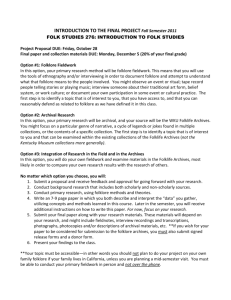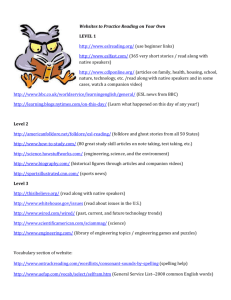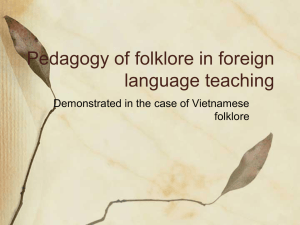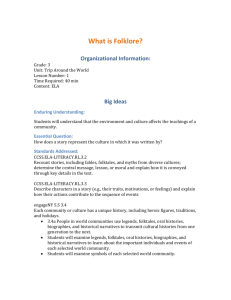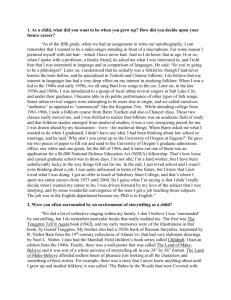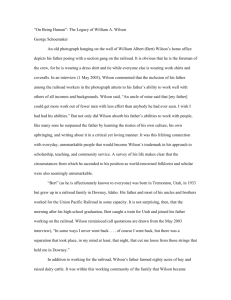The Folklore Archives in Special Collections at the University of Utah
advertisement
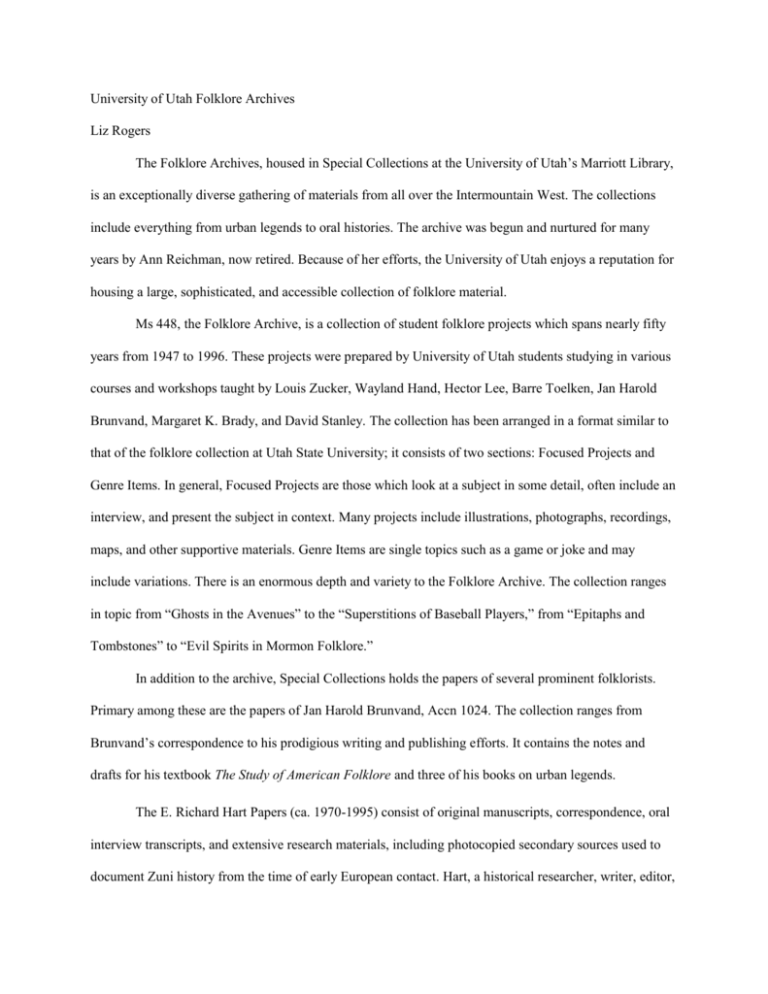
University of Utah Folklore Archives Liz Rogers The Folklore Archives, housed in Special Collections at the University of Utah’s Marriott Library, is an exceptionally diverse gathering of materials from all over the Intermountain West. The collections include everything from urban legends to oral histories. The archive was begun and nurtured for many years by Ann Reichman, now retired. Because of her efforts, the University of Utah enjoys a reputation for housing a large, sophisticated, and accessible collection of folklore material. Ms 448, the Folklore Archive, is a collection of student folklore projects which spans nearly fifty years from 1947 to 1996. These projects were prepared by University of Utah students studying in various courses and workshops taught by Louis Zucker, Wayland Hand, Hector Lee, Barre Toelken, Jan Harold Brunvand, Margaret K. Brady, and David Stanley. The collection has been arranged in a format similar to that of the folklore collection at Utah State University; it consists of two sections: Focused Projects and Genre Items. In general, Focused Projects are those which look at a subject in some detail, often include an interview, and present the subject in context. Many projects include illustrations, photographs, recordings, maps, and other supportive materials. Genre Items are single topics such as a game or joke and may include variations. There is an enormous depth and variety to the Folklore Archive. The collection ranges in topic from “Ghosts in the Avenues” to the “Superstitions of Baseball Players,” from “Epitaphs and Tombstones” to “Evil Spirits in Mormon Folklore.” In addition to the archive, Special Collections holds the papers of several prominent folklorists. Primary among these are the papers of Jan Harold Brunvand, Accn 1024. The collection ranges from Brunvand’s correspondence to his prodigious writing and publishing efforts. It contains the notes and drafts for his textbook The Study of American Folklore and three of his books on urban legends. The E. Richard Hart Papers (ca. 1970-1995) consist of original manuscripts, correspondence, oral interview transcripts, and extensive research materials, including photocopied secondary sources used to document Zuni history from the time of early European contact. Hart, a historical researcher, writer, editor, and director/organizer of conferences and institutions focusing on the environment and culture of the West, also prepared and presented historical background for court cases that, over a period of years, secured rights and properties for the Zunis. Hart also worked with the Western Shoshone Nation, and some of that material is also found in his collection. The Institute of the American West Records (Ms 582), also donated by Hart, consist of notes, correspondence, planning schedules, presentation proposals, and background materials for conferences and other activities of the institute, originally based in Sun Valley, Idaho. Primary source materials include original manuscripts, conference transcripts, and correspondence. Numerous newspaper clippings and printed information are also included. The annual conferences, held annually, were successful from their inception with topics such as the myths of the American West, the West in film, the writer and the West, and the cowboy hero. Much of the collection concerns the planning, execution, and follow-up of the events and the use made of the materials generated by the conferences, e.g., broadcasts and publications. The Institute of the North American West Records (Accn 1293) contain the papers of the nonprofit organization that produced the conferences on the history, economics, and cultures of the North American West from Canada to Mexico. It also contains folk arts materials specific to New Mexico, as well as generalized folk arts, such as Native art, Zuni crafts, and other materials. Mormoniana, or the collection of Mormon culture, is another area of interest in Special Collections. The Folklore Archive contains a large number of anecdotal documents including the J. Golden Kimball Papers (Ms 662), which contain a large amount of correspondence devoted to his mission and later life (see chapter 15). The Hiram Clawson Papers (Ms 40) contain not only correspondence from Clawson’s days with the Nauvoo Legion but continue on to his days on the Salt Lake stage. The Rutger Clawson Papers (Ms 481) contain memoirs which encompass, among other things, Clawson’s trips to the state penitentiary where he was sentenced for practicing plural marriage. Finally, there are two other collections of interest to folklorists in Utah. The First Unitarian Church of Salt Lake City Papers (Ms 508) contain an article written by David Utter, a Unitarian minister who wrote the first known article on Utah folklore. The Lester Hubbard Folklore Collection (Ms 158) contains Dr. Hubbard’s extensive gatherings of early Utah stories, songs, tales, legends, and customs (see chapter 6).

